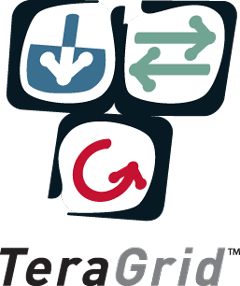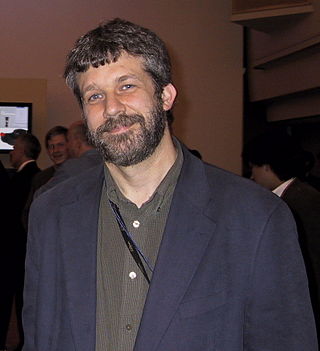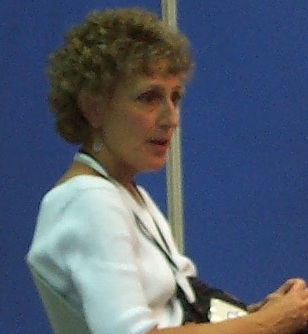Related Research Articles

A supercomputer is a computer with a high level of performance as compared to a general-purpose computer. The performance of a supercomputer is commonly measured in floating-point operations per second (FLOPS) instead of million instructions per second (MIPS). Since 2017, there have existed supercomputers which can perform over 1017 FLOPS (a hundred quadrillion FLOPS, 100 petaFLOPS or 100 PFLOPS). For comparison, a desktop computer has performance in the range of hundreds of gigaFLOPS (1011) to tens of teraFLOPS (1013). Since November 2017, all of the world's fastest 500 supercomputers run on Linux-based operating systems. Additional research is being conducted in the United States, the European Union, Taiwan, Japan, and China to build faster, more powerful and technologically superior exascale supercomputers.

Argonne National Laboratory is a federally funded research and development center in Lemont, Illinois, United States. Founded in 1946, the laboratory is owned by the United States Department of Energy and administered by UChicago Argonne LLC of the University of Chicago. The facility is the largest national laboratory in the Midwest.

Jack Joseph Dongarra is an American computer scientist and mathematician. He is the American University Distinguished Professor of Computer Science in the Electrical Engineering and Computer Science Department at the University of Tennessee. He holds the position of a Distinguished Research Staff member in the Computer Science and Mathematics Division at Oak Ridge National Laboratory, Turing Fellowship in the School of Mathematics at the University of Manchester, and is an adjunct professor and teacher in the Computer Science Department at Rice University. He served as a faculty fellow at the Texas A&M University Institute for Advanced Study (2014–2018). Dongarra is the founding director of the Innovative Computing Laboratory at the University of Tennessee. He was the recipient of the Turing Award in 2021.

High-performance computing (HPC) uses supercomputers and computer clusters to solve advanced computation problems.
Ian Tremere Foster is a New Zealand-American computer scientist. He is a distinguished fellow, senior scientist, and director of the Data Science and Learning division at Argonne National Laboratory, and a professor in the department of computer science at the University of Chicago.
Carl Kesselman is an American computer scientist specializing in grid computing technologies. This term was developed by him and professor Ian Foster in the book The Grid: Blueprint for a New Computing Infrastructure. He and Foster are winners of the British Computer Society's Lovelace Medal for their grid work. He is institute fellow at the University of Southern California's Information Sciences Institute and a professor in the Epstein Department of Industrial and Systems Engineering, at the University of Southern California.

TeraGrid was an e-Science grid computing infrastructure combining resources at eleven partner sites. The project started in 2001 and operated from 2004 through 2011.

Charlie Catlett is a senior computer scientist at Argonne National Laboratory and a visiting senior fellow at the Mansueto Institute for Urban Innovation at the University of Chicago. From 2020 to 2022 he was a senior research scientist at the University of Illinois Discovery Partners Institute. He was previously a senior computer scientist at Argonne National Laboratory and a senior fellow in the Computation Institute, a joint institute of Argonne National Laboratory and The University of Chicago, and a senior fellow at the University of Chicago's Harris School of Public Policy.

Edge computing is a distributed computing paradigm that brings computation and data storage closer to the sources of data. This is expected to improve response times and save bandwidth. Edge computing is an architecture rather than a specific technology, and a topology- and location-sensitive form of distributed computing.

Maxine D. Brown is an American computer scientist and retired director of the Electronic Visualization Laboratory (EVL) at the University of Illinois at Chicago (UIC). Along with Tom DeFanti and Bruce McCormick, she co-edited the 1987 NSF report, Visualization in Scientific Computing, which defined the field of scientific visualization.
Nimbus is a toolkit that, once installed on a cluster, provides an infrastructure as a service cloud to its client via WSRF-based or Amazon EC2 WSDL web service APIs. Nimbus is free and open-source software, subject to the requirements of the Apache License, version 2.
Ignacio Martín Llorente is an entrepreneur, researcher and educator in the field of cloud and distributed computing. He is the director of OpenNebula, a visiting scholar at Harvard University and a full professor at Complutense University. Dr. Llorente is a IEEE Senior Member. He holds a Ph.D in Computer Science from UCM and an Executive MBA from IE Business School.
Mobile Cloud Computing (MCC) is the combination of cloud computing and mobile computing to bring rich computational resources to mobile users, network operators, as well as cloud computing providers. The ultimate goal of MCC is to enable execution of rich mobile applications on a plethora of mobile devices, with a rich user experience. MCC provides business opportunities for mobile network operators as well as cloud providers. More comprehensively, MCC can be defined as "a rich mobile computing technology that leverages unified elastic resources of varied clouds and network technologies toward unrestricted functionality, storage, and mobility to serve a multitude of mobile devices anywhere, anytime through the channel of Ethernet or Internet regardless of heterogeneous environments and platforms based on the pay-as-you-use principle."
The Open Commons Consortium is a 501(c)(3) non-profit venture which provides cloud computing and data commons resources to support "scientific, environmental, medical and health care research." OCC manages and operates resources including the Open Science Data Cloud, which is a multi-petabyte scientific data sharing resource. The consortium is based in Chicago, Illinois, and is managed by the 501(c)3 Center for Computational Science Research.
Many universities, vendors, institutes and government organizations are investing in cloud computing research:

Valerie Elaine Taylor is an American computer scientist who is the director of the Mathematics and Computer Science Division of Argonne National Laboratory in Illinois. Her research includes topics such as performance analysis, power analysis, and resiliency. She is known for her work on "Prophesy," described as "a database used to collect and analyze data to predict the performance on different applications on parallel systems."
Michela Taufer is an Italian-American computer scientist and holds the Jack Dongarra Professorship in High Performance Computing within the Department of Electrical Engineering and Computer Science at the University of Tennessee, Knoxville. She is an ACM Distinguished Scientist and an IEEE Senior Member. In 2021, together with a team al Lawrence Livermore National Laboratory, she earned a R&D 100 Award for the Flux workload management software framework in the Software/Services category.
Pegasus is an open-source workflow management system. It provides the necessary abstractions for scientists to create scientific workflows and allows for transparent execution of these workflows on a range of computing platforms including high performance computing clusters, clouds, and national cyberinfrastructure. In Pegasus, workflows are described abstractly as directed acyclic graphs (DAGs) using a provided API for Jupyter Notebooks, Python, R, or Java. During execution, Pegasus translates the constructed abstract workflow into an executable workflow which is executed and managed by HTCondor.

Cerebras Systems Inc. is an American artificial intelligence company with offices in Sunnyvale, San Diego, Toronto, Tokyo and Bangalore. Cerebras builds computer systems for complex artificial intelligence deep learning applications.
Manish Parashar is a Presidential Professor in the School of Computing, Director of the Scientific Computing and Imaging (SCI) Institute and Chair in Computational Science and Engineering at the University of Utah. He also currently serves as Office Director in the US National Science Foundation’s Office of Advanced Cyberinfrastructure. Parashar is the editor-in-chief of IEEE Transactions on Parallel and Distributed Systems, and Founding Chair of the IEEE Technical Community on High Performance Computing. He is an AAAS Fellow, ACM Fellow, and IEEE Fellow.
References
- 1 2 K. Keahey, I. Foster, T. Freeman, and X. Zhang, "Virtual Workspaces: Achieving Quality of Service and Quality of Life in the Grid", Scientific Programming ; 13(4), pp. 265-276 (2005)
- 1 2 A Nimbus Rises in the World of Cloud Computing, by PHYS staff, in Phys.org ; published 8 May 2019; retrieved 15 May 2020
- 1 2 3 K. Keahey, J. Anderson, P. Ruth, J. Colleran, C.Hammock, J. Stubbs, and Z. Zhen "Operational Lessons from Chameleon", Proceedings of the Humans in the Loop: Enabling and Facilitating Research on Cloud Computing; 5 pp. 1–7 (2019)
- ↑ TACC Puts Chameleon Cloud Testbed into Production, by Inside HPC staff, in HPCwire; published 29 July 2015; retrieved 15 May 2020
- 1 2 Lessons from the Grid: An Interview with Argonne’s Kate Keahey, by Nicole Hemsoth, in HPCwire; published 25 January 2011; retrieved 13 May 2020
- ↑ "Prof Kate Keahey, research profile – personal details Argonne National Laboratory (ANL)" . Retrieved 15 May 2020.
- 1 2 A. Andrieux, K. Czajkowski, A. Dan, K. Keahey, H. Ludwig, J. Pruyne, J. Rofrano, S. Tuecke, and M. Xu, "Web services agreement specification (WS-Agreement)", Global Grid Forum ; pp. 265-276 (2007)
- 1 2 F. Liu, K. Keahey, P. Riteau, and J.B Weissman "Dynamically negotiating capacity between on-demand and batch clusters", IEEE ; pp. 493-503 (2018)
- ↑ "Katarzyna Keahey | Argonne National Laboratory". www.anl.gov. Retrieved 16 May 2020.
- ↑ "NSF renews Chameleon Cloud testbed project with $10m grant", by Sebastian Moss, in Data Center Dynamics; published 20 September 2017; retrieved 19 May 2020
- ↑ "Thought Leaders in the Cloud: Talking with Kate Keahey, Creator of Nimbus", by Robert Duffner, in Microsoft Azure ; published 10 December 2010; retrieved 15 May 2020
- ↑ Kate Keahey in ScienceDirect
- ↑ K. Leahey, R. Figueiredo, J. Fortes, M. Tsugawa, and T. Freeman "Science Clouds: Early Experiences in Cloud Computing for Scientific Applications", Cloud computing and applications; pp. CCA-08 (2008)
- ↑ K. Keahey, P. Riteau, J. Anderson and Z. Zhen, "Science Clouds: Early Experiences in Cloud Computing for Scientific Applications", Institute of Electrical and Electronics Engineers (IEEE); pp. 41-49 (2019)
- ↑ P. Marshall, K. Keahey and T. Freeman "Improving Utilization of Infrastructure Clouds", IEEE ; pp. 205-214 (2011)
- ↑ B. Sotomayor, K. Keahey, and I. Foster "Combining batch execution and leasing using virtual machines", IEEE ; pp. 87-96 (2008)